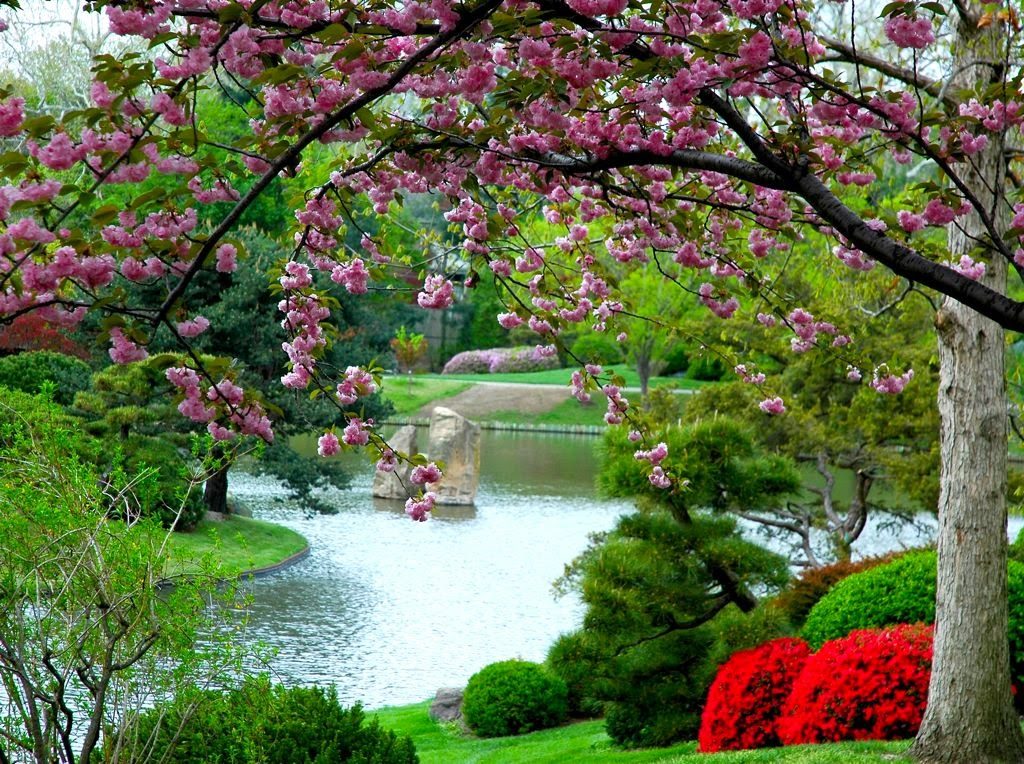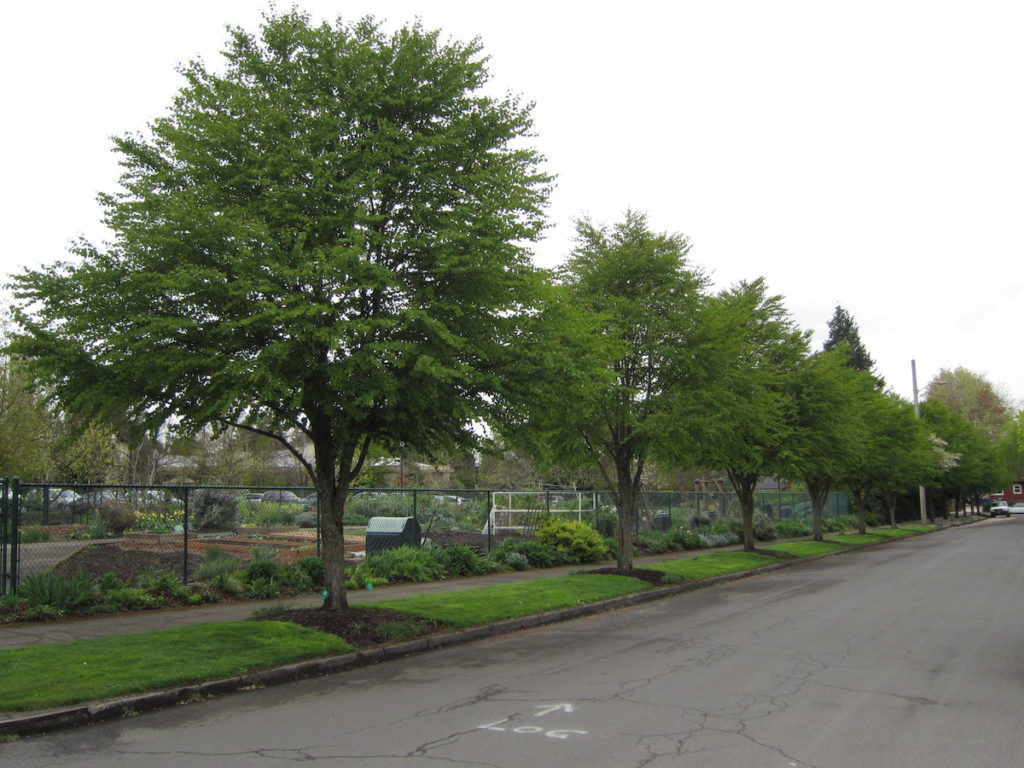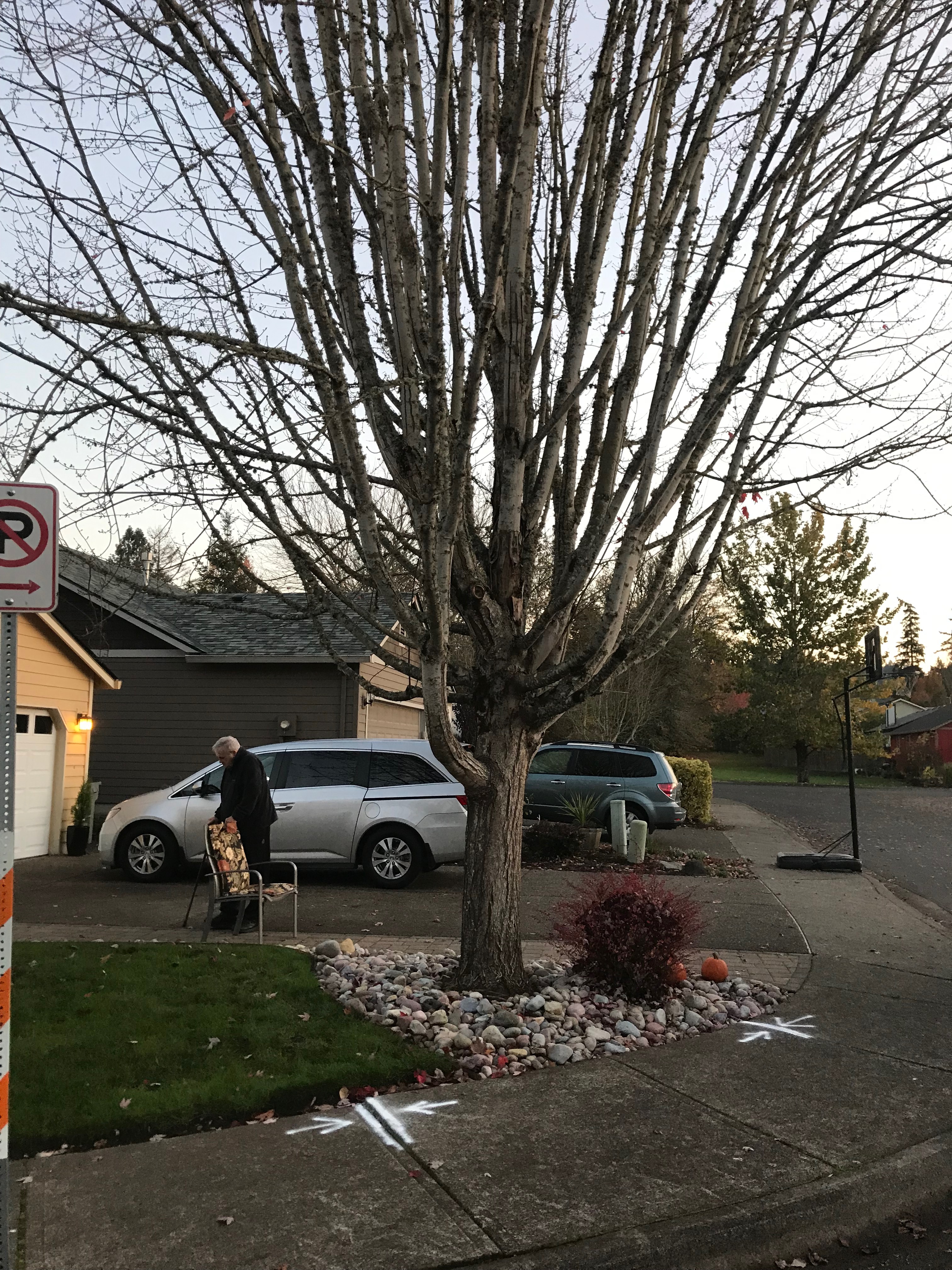This video is another example of a misplaced street tree thanks to the incompetence of city government officials. Cities all over America are placing the wrong street trees in the wrong places costing city residents millions of dollars and the unnecessary loss of wonderful trees. It’s time that city officials begin consulting with competent arborists and change their policies and start planing the right trees in the right place.
Tag Archives: Street Trees
Nathan’s Best Picks for Columnar Street Trees

By Nathan Lawrence—ISA Cerified Arborist, OSU Master Gardener and owner of Good News Tree Service, Inc. at GoodNewsTree.com in Wilsonville, Oregon
The following is my list of the best street trees for small front yards that have space for only narrow, non-spreading street trees. All of these trees grow well in the western valleys of the Pacific Northwest, are not messy, and have little or no problems with diseases based on my decades of experience as a tree care provider and plant health care expert. You can search online for photos of these trees to see what they look like.
- Dogwood—Hybrid White Dogwood (Cornus ‘Eddie’s White Wonder’): This unusual hybrid is a cross between our native Western dogwood, Cornus nuttallii, and the Eastern North American species, Cornus florida. The large (four inch diameter), bold flowers open in early spring and have broad overlapping bracts (false petals) that are gleaming white and abundant against a dark green foliage making for a striking display. The tree has a narrow, upright and rather pyramidal in form, with slightly drooping branching. It has shown resistance to dogwood anthracnose, a common foliage disease. This tree grows to height of 20 to 30 feet and a width of 15 to 20 feet. The leaves turn reddish pink in the autumn and small red berries decorate its branches in the winter. The tree can tolerate full sun to partial shade.
- Dogwood—Starlight Dogwood (Cornus x nuttalii ‘Starlight’): A close relative to Venus is the variety Starlight® which is the result of crossing Korean dogwood with the Pacific dogwood. 35 feet high and 20 feet wide Resistant to anthracnose. Abundance of 4-5” creamy white flowers create a showy spring display against its deep green foliage. Orange strawberry-like fruit in early fall, followed by a show of red fall color. Resistant to anthracnose. Full sun to partial shade; size 25-30 feet tall by 15-20 feet wide.
- Ginkgo—Sky Tower Ginkgo (Ginkgo biloba ‘JN9 Sky Tower’): Rich green foliage. Narrow crown. Brilliant yellow fall color. Height 20 feet by 6 feet wide. Make sure you plant only male trees. Female trees produce a messy and nasty-smelling fruit.
- Hornbeam—American Hornbeam (Carpinus caroliniana): This North American native grows to about 30 feet tall and 20 feet wide. It is slow-growing, deciduous, small to medium-sized with an attractive globular form. It prefers moist soil and is not drought tolerant.
- Hornbeam— (Carpinus Lucus pyramidal): Narrow, slender growing habit. Dense canopy. 16 to 18 foot height. Attractive yellow, green catkins in the spring.
- Hornbeam—Upright European Hornbeam (Carpinus betulus ‘fastigiata’): Dense green foliage with golden fall color. Height 40 feet and width 20 feet.
- Maple—Crimson Sentry (Acer platanoides ‘Crimson Sentry’): This tree grows to a height of 25 feet and width of 15 feet. It has purple leaves, which turn maroon to reddish bronze leaves in the fall. Oregon State University says of this tree, “In western Oregon the trees appear rather susceptible to powdery mildew, a fungal disease. This is especially noticeable in mid-to-late-summer. The affected leaves become a dull maroon color followed by a white-gray color, as if dusted with powdered sugar. One authority suggested that Crimson Sentry™ should not be recommended for mass or street plantings ‘unless a ghostly pallor on purple foliage is actually wanted.’”
- Maple—Karpick Red Maple (Acer rubrum ‘Karpick’): This columnar red maple grows to a height of 45 feet tall and 20 wide with red-orange foliage in the fall.
- Oak—Columnar English Oak (Quercus robur ‘Fastigiata’) and Crimson Spire Oak (Quercus robur x Q. alba ‘Crimschmidt’): These trees are slow to moderate growing reaching a height of 50 to 60 feet tall and 15 to 20 feet wide. They prefer full sun and well-drained soil. They are extremely adaptable and very tolerant of urban conditions. The trees tolerate drought, but do best with occasional irrigation.
- Oak—Pacific Brilliance Pin Oak (Quercus palustris ‘Pacific Brilliance’): The crown height is 50 feet and the crown spread is 20 to 25 feet at maturity.
- Paperbark Maple (Acer griseum): This tree grows to a height of 20 to 30 feet and width of 12 to 20 feet. Its crown is oval to oval rounded. Tree is noted for its unique copper orange to cinnamon reddish brown peeling bark and its showy orange to red colored leaves in the fall.
- Stewartia—Japanese Stewartia (Stewartia pseudocamellia): This slow-growing tree grows to crown height of 12 to 40 feet and a crown spread 10 to 25 feet with white camellia-like flowers that bloom in the late spring. Several smaller varieties of stewartia are available too (e.g. Korean stewartia [Stewartia koreana] and tall stewartia [Stewartia monadelpha]).
- Tupelo, Afterburner (Nyssa sylvatica ‘David Odom’): This tree grows moderately fast to a height of 35 feet and a crown spread of 20 feet. The shape of its crown is upright and pyramidal to oval and is symmetrical and uniform. Its high gloss foliage is bright green tuning bright red in the fall. It has a blue-black berry-like fruit that’s less than a half-inch in size.
The Importance of Planting Right the Tree in the Right Place

Why is it important to plant the right tree in the right place as opposed to the wrong tree in the wrong place? Here are the reasons why:
Planting the Wrong Tree in the Wrong Place Is…
- Aesthetically detrimental: The tree may outgrow it’s spot and come into conflict with buildings, roadways, and hurt or destroy landscapes and lawns thus reducing liveability of property and property values.
- Expensive: A misplaced tree may have to be pruned or removed in the future at great expense and causing a negative environmental impact.
- Damaging to infrastructure, which is expensive to repair: A misplaced tree may eventually cause infrastructure damage (to sidewalks, driveways, house foundations, underground utilities, lawns, landscape and irrigations systems).
- Inconvenient: A misplaced tree may eventually block or cause damage to driveways, sidewalks, roadways, windows and street lights and come into conflict with buildings. Moreover, a misplaced tree may result in cracked foundations and patios, broken water pipes, clogged sewer pipes and rain drains, and come into conflict with and cause damage to roadways, sidewalks, and overhead utility wires.
- Environmentally detrimental: Having to remove a misplaced mature tree is not only a waste of financial resources and human energy, but it is detrimental to the environment. This because when a mature tree is removed, all the benefits a large tree provides humans and the environment are lost.
- Decreases liveability: Trees too large for the area will take over a small yard and decrease usability of the yard and make the yard appear smaller.
- Conflicts with neighbors: Misplaced trees often grow to where they are over-hanging neighbor’s property causing bad neighborly relations that may last for years. Some people may be forced to move because of this problem.
- Decreases home value: Trees that are too large for the yard make the yard appear smaller than it really is.
Planting the Right tree in the Right Place Is Beneficial…
- Aesthetically: A well placed tree enhances the landscape, the house and property.
- Economically: A well placed tree saves on future tree care, and adds assessed value to one’s property.
- Environmentally:
- And it feels good, brings joy and pleasure to people because it’s the right tree in the right place
Proactive Tree Care
- Placing the right tree in the right place is not only good for the planet and is the right thing to do, but it has many other benefits as well. This includes…
- Saving money in the long run by properly caring for trees. Proactive or preventive tree care is always less expensive than crisis management tree care.
- It makes sense economically and environmentally to care for a tree before it causes damage or is a hazard. This involves putting the right tree in the right spot to begin with and then properly caring for it along the way.
Addressing Street and Front Yard Tree Issues in Cities

For many years, I have seen cities in my area planting the wrong street trees in the wrong places. This folly has been a boon to my tree service business, but, overall, removing perfectly good trees because they have been planted in the wrong place is a bad thing for the tree, for the environment and for people’s pocketbooks.
So yesterday, I had a meeting with a City of Wilsonville planner to discuss with him ways to improve street tree placement in our city and some strategies on how to preserve existing mal-placed street trees. Below were my talking points. It was an excellent meeting, and hopefully something good will come of it.— Nathan
All well-informed people agree that we need to plant trees for the benefit of the planet. All of our lives depend on it for many reasons.
In Genesis 2:15, we read,
Then the LORD God took the man and put him in the garden of Eden to tend and keep it.
This is a standard English translation of this verse. If we look at the original Hebrew of this text that is behind the English, this verse could read,
Then the Yehovah Elohim took the man and put him in the garden of Eden to tend, serve, by implication to worship the Creator by taking care of and to keep, guard, protect, attend to, regard, preserve, reserve, save the garden.
This expanded translation sheds a whole new light on how the Creator expected man to take care of the environment. What it doesn’t say is to rape, pillage, recklessly exploit or indiscriminately remove trees from the garden!
Taking care of the garden (the earth) was the third command that the Creator gave to the first humans. Tree care and preservation is a divine mandate!
Even though my roots as a tree care professional go back more than 50 years, I started getting a clue about the importance tree preservation about 20 years ago when I began educating myself about tree preservation. Then about 12 years ago I became an ISA Certified Arborists and obtained my ODA Commercial Pesticide Applicators license and purchased the equipment to fertilize and care for ailing trees. I realized that we were removing too many trees that could be saved, so I learned how to save trees by returning them to health. Since then, we have saved hundreds of trees from the chain saw. HalleluYah!
It is our responsibility as stewards of the environment to plant the right tree in the right place, so that we don’t have to remove a valuable tree later.
The wrong tree in the wrong place causes no end of damage to hard surfaces (roads, driveways and sidewalks), for utilities (street lights, sewer and water pipes, irrigations systems), and this can result in thousands of dollars of damage to private and public property, potential legal liabilities for everyone, and thousands of dollars in tree mitigation including pruning, root cutting and removals, and, finally, often a perfectly good trees has to be removed resulting in one less oxygen-producing tree on planet earth all because people put the wrong tree in the wrong place.
Continue readingPlant the Right Street Tree in the Right Place

Well chosen and properly maintained street trees add much value, livability to a neighborhood and to our planet.
Street Tree Recommendations for the Western Valleys of the Pacific Northwest
Why This Is Important and How It Affects YOU
The following list of recommended columnar or semi-columnar street trees for the western valleys of the Pacific Northwest is the convergence of several efforts on the author’s part.
This list is the distillation—the crème de la crème—of the analysis of numerous varieties of street trees from various lists compiled by numerous people, organizations and local municipalities. The best choices, in the author’s opinion, have been carefully selected. (More suitable street trees are being added to the list as they come to the author’s attention. So what makes the author’s opinion worth anything? Glad you asked.
Nathan Lawrence, ISA Certified Arborist and a second-generation Pacific Northwest arborist and horticulturist who has been earning a living caring for trees in Northwest Oregon since 1972, has put this list together based on long experience dealing with countless varieties of trees and learning how they react in numerous situations including wind, rain, ice, snow, blights, drought, attacks from pests, construction trauma, lightening, poor growth habits, structural failures, human neglect and more.
While owning and operating a tree care company in Northwest Oregon since 1985, we have Continue reading
The Wrong Street Tree in the Wrong Place…BIG PROBLEMS!
Street trees are beautiful to look at when driving through a neighborhood. They add value to a house and neighborhood, improve livability, are good for the earth and environment, and provide so many other benefits, as we’ve noted elsewhere on this blog (https://goodnewstree.com/2018/10/11/how-trees-benefit-you/ and https://goodnewstree.com/2018/10/11/why-humans-cant-live-without-trees/).
However, the wrong tree in the wrong place can cause no end of problems for the owner of the tree. Fixing some of these problems can be extremely expensive. That’s why it’s important to plant the right street tree in the right place (as we will note in our next blog post).
In our decades as arborists, we’ve seen it all including the damage that misplaced trees can do to foundations, sidewalks, driveways, walls, houses, cars, near fatalities due to limb breakage and trunk failures, destroyed street lights, impacted utilities, plugged sewer pipes and busted water meters and pipes, and more.
Here are just a few examples of the problems the wrong tree in the wrong place can cause.

Here is a street tree totally enveloping a street light. Someone wasn’t thinking when they planted this tree!

Here is a public sidewalk that has been lifted by a street tree. This is a trip hazard to pedestrians and legal liability for someone.

A pedestrian actually caught a toe on and tripped over this tree root lifted sidewalk and did a nose plant on the cement. Not good!

This tree was too large for its spot. It was lifting the sidewalk in two places and had utilities running underneath it was well. Underground utilities and tree roots often clash causing all kinds of damage and expenses.

Some trees are susceptible to splitting out due to weak trunk and branch structures. These are not good street tree choices, especially when they break out and land on streets, cars and houses.

We had to remove this weak crotched tree when part of it split out and landed in the cul-de-sac after a little wind storm.

This sweetgum street tree is loaded with hard spikey gumballs, which fall and then roll down the sloping lawn onto the sidewalk and street where people walk. It’s not hard for someone to twist an ankle while walking over a hard surface covered with golf ball like gumboils. If this happens, I wonder who’s going to pay for the medical bills?

